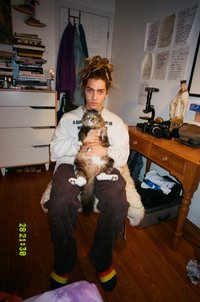Abdul Kircher

Abdulhamid Kircher’s photography and written works document the beauty and the harshness of lived experience. Having once looked to strangers, he now focuses inward, using his art as a mode of reflection for his personal and professional evolution; in aptitude, perception, mindset and motivation. Kircher uses other media including sculpture, installation, printmaking and, journalling and text to explore the moments in between one image and the next, fusing documentation and experimentation. In this process, he employs specialised tools such as microscopes, dental cameras, and binoculars to see beyond what the naked eye can.
What cameras do you use and why?
“Recently, I’ve been using a 35-millimetre film camera connected to an Olympus medical microscope from the 30s. I also found these Nicnon binocular cameras that are used by the Israeli military and have a 35-millimetre camera attached.
Are there nuances embedded within your work?
“My work isn’t necessarily trying to tell a specific narrative or teach people a lesson. Everything I make is based on what I feel drawn to. I follow my gut in a moment and see what unfolds from said moment. We play such little roles in this world, I want to be able to dissect the things that surround me and present those things to the world without expectation of how people will process or perceive them.”
How does emotion come into play in your project, Rotting From Within, in which you set about to explore the complexities of your relationship with your father?
“Whilst shooting 'Rotting From Within' I kept a diary in which I made note of some of the feelings I was having towards my father and family, trying to make sense of them using my imagery.
When I put the show together, I didn’t want it to be overly thought out beforehand. I had one image in mind that I wanted to start with as central in the exhibition space, which was my dad with me as a newborn. I really tried to use the moment I was in, and the feelings I was having towards my dad and family in that moment, to reflect on what was being put up onto the wall. That’s how I want to approach and produce future iterations of work: by allowing how I’m feeling in the moment to dictate how something is put together. A new iteration each time, featuring new images and new layouts.”




